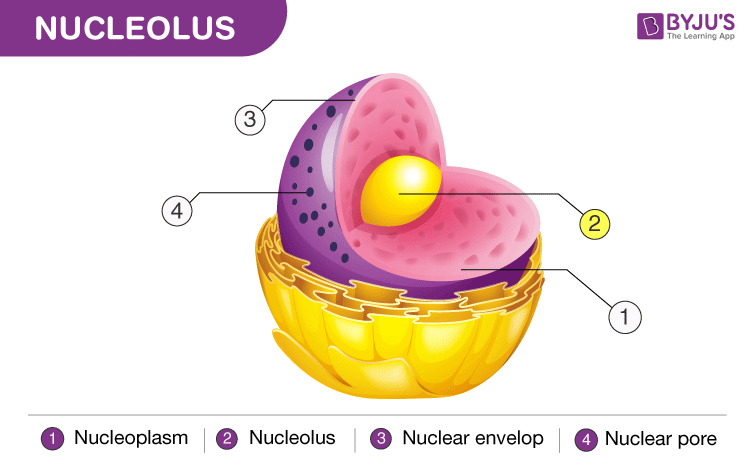The nucleolus is the distinct structure present in the nucleus of eukaryotic cells. Primarily, it participates in assembling the ribosomes, alteration of transfer RNA and sensing cellular stress. The nucleolus is composed of RNA and proteins, which form around specific chromosomal regions.

Nucleolus
It is one of the main components of the nucleus. The chain of RNA and DNA along with other components form the structural components. The main components of the nucleolus are ribonucleic acid, deoxyribonucleic acid and proteins.
Also Read: Nucleus
Structure of the Nucleolus
In eukaryotic cells, nucleolus has a well-ordered structure with four main ultrastructural components. The components can be further identified as:
- Fibrillar Centers: It is the place where the ribosomal proteins are formed.
- Granular Components: Before ribosomes are formed, these components have rRNA that binds to ribosomal proteins.
- Dense Fibrillar Components: It has new transcribed RNA, which connects to the ribosomal proteins.
- Nucleolar vacuoles: It is present only in plant cells.
The ultrastructure of the nucleolus can be easily visualized through an electron microscope. The arrangement of the nucleolus within the cell can be clearly studied by the techniques – fluorescent recovery after photobleaching and fluorescent protein tagging.
The nucleolus of several plant species has very high concentrations of iron in contrast to the human and animal cell nucleolus.
Nucleolus Function
The nucleolus is considered as the brain of the nucleus, covering nearly 25% volume of the nucleus. Primarily, it takes part in the production of subunits that unites to form ribosomes. Hence, nucleolus plays an important role in the synthesis of proteins and in the production of ribosomes in eukaryotic cells.
Difference Between Nucleus and Nucleolus
The difference between nucleus and nucleolus is mentioned below:
| Nucleus | Nucleolus |
| Large in size | Very small in size |
| Bound by the nuclear envelope | It has no limiting membrane |
| It contains chromosomes. | It does not hold any chromosomes |
| It is rich in DNA, the genetic material | It is rich in RNA |
Also Read: Nucleoplasm
For more information on nucleolus, its structure, function and the difference between nucleus and nucleolus, keep visiting BYJU’S website or download the BYJU’S app for further reference.
Frequently Asked Questions
What is the function of nucleolus?
Nucleolus helps in protein synthesis and production of the ribosome in the cells.
Where is the nucleolus located in the cell?
The nucleolus is located inside the nucleus of the eukaryotic cell. It is surrounded by a membrane inside the nucleus.
What does the nucleolus contain?
The nucleolus contains DNA, RNA and proteins. It is a ribosome factory. Cells from other species often have multiple nucleoli.
Is nucleolus an organelle?
The nucleolus is an organelle, and a very unusual one because it is devoid of lipid bilayers, which are characteristic of other organelles.
What would happen if there is no nucleolus in the cell?
If the nucleolus didn’t exist, there would be no production of ribosomes and there would be no synthesis of proteins.

Comments